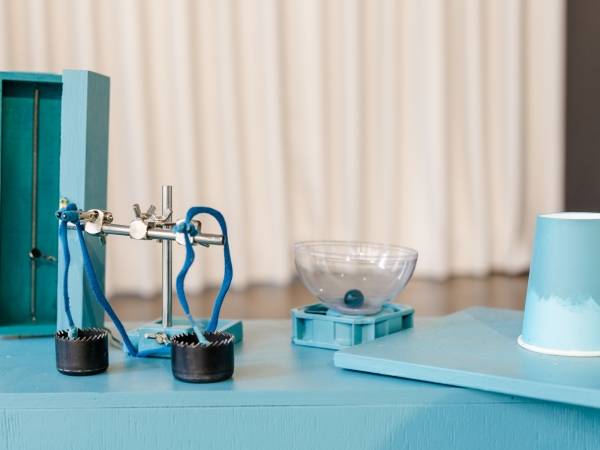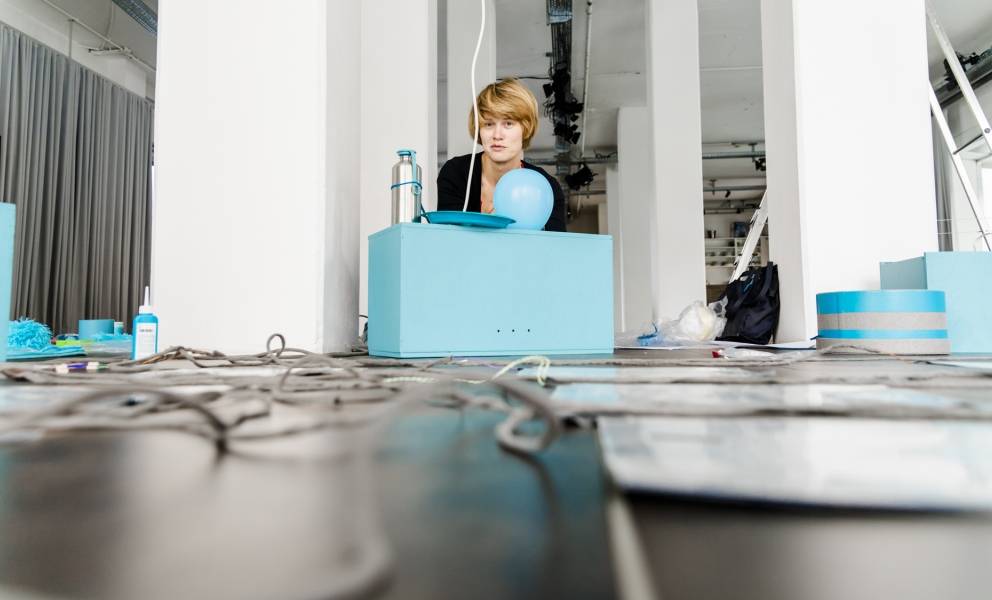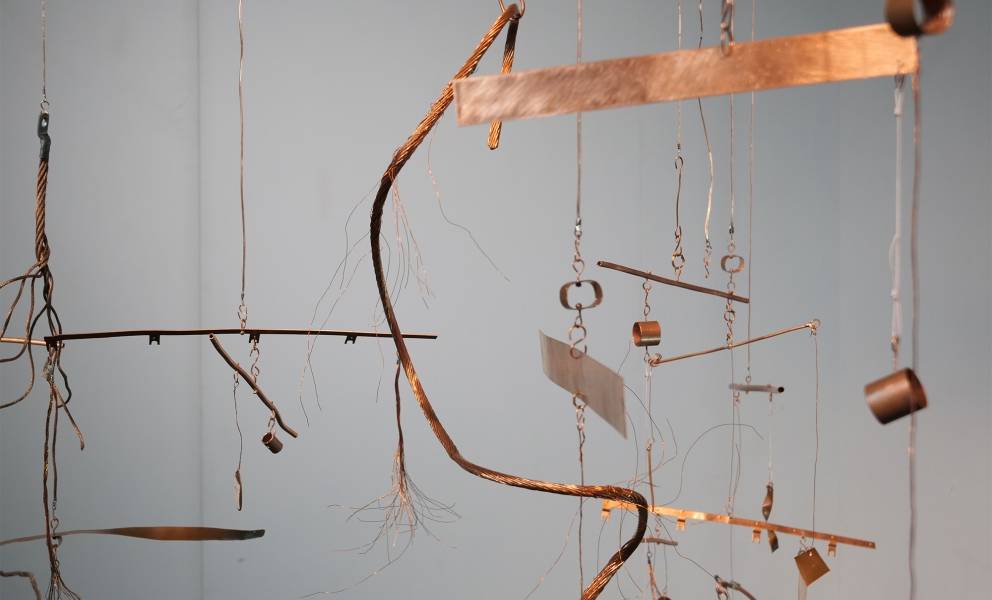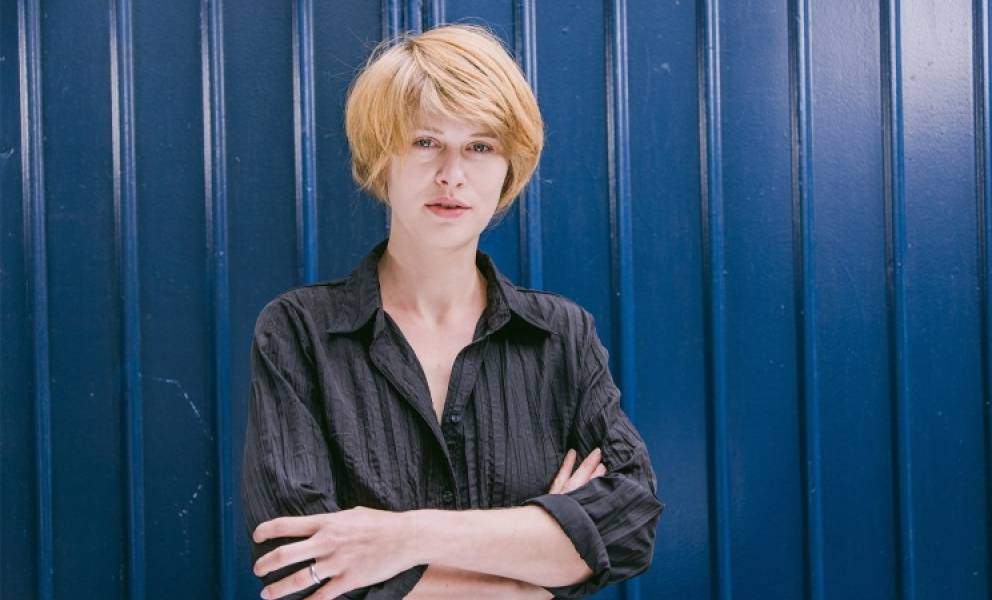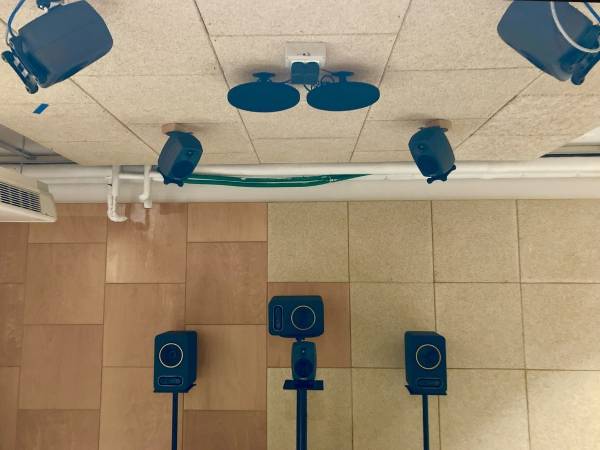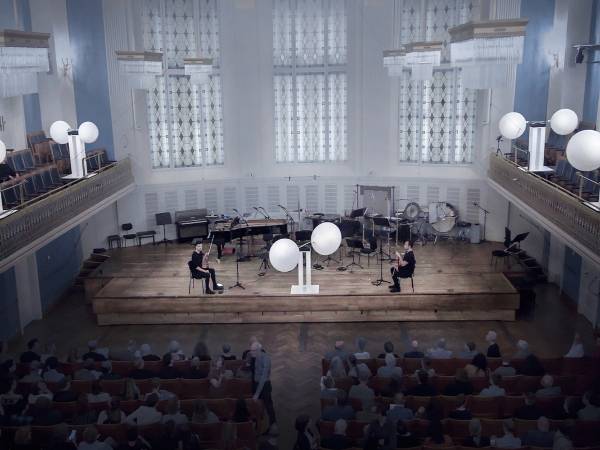5 Minuten
As an artist, I have always been interested in social and physical systems of order and communication - relationships between people and things.
A sound is created by the meeting of two elements: the bow on the string, the heel on the floor, the vocal cords on each other, etc. It is also defined by the space in which it is created and the position of the listener.
It is also defined by the space in which it is created and the position of the person listening. In a broader sense, this also applies to reproduced and acousmatic sounds, where electricity becomes an important player: Sound as moving air meets membrane (recording). The membrane then moves air again and produces sound (reproduction).
Sound art has been at the center of my artistic work since I graduated from the Academy of Fine Arts. I often use sound bodies, noise, electronics, radio interviews and voices in spatial installations and objects.
Concepts of new materialism, initiated by Donna Haraway and continued by theorists such as Karen Barad, understand dynamics not only as ideal constructs, but are conceived from the material. From this perspective, I see sound-artistic practices as a form to implement physical-habitual forms of knowledge and to allow the recognition of structural and functional relationships to be sensually experienced in a research-based approach.
Influenced by phenomenological thinking, my works often start from certain materials in order to gradually view them in their socio-cultural context and to understand them paradigmatically for contexts of meaning. Research and contextualized work with regard to socio-political, contemporary historical and cultural-theoretical issues are a cross-sectional matter.
I like to use the sensual potential of spatial installations to consider ambiguous processes and simultaneities, while remaining with a simple and comprehensible form.
As a musician, I have worked for many years with noises as sound material, with what shapes our everyday listening environment, and use it in a targeted way. To this end, I build devices that are usually created and staged by repurposing found objects in combination with DIY electronics. The digital aspect usually takes a back seat to the mechanical aspect in my work. I use simple circuits with microcontrollers such as Arduinos and transistor and relay circuits to control motors and other actuators. For interacting playback of audio material, I often use circuit boards such as Wav-Shields from Robertsonic, which control the parameters of the sound playback through connected circuits and sensors.
Geräuschteppich
The sound carpet (Geräuschteppich), for example, is an environment for a concert experience for active listeners. Pressure sensors under the carpet control various sound objects that have been developed from modified and motorized everyday objects. The various trigger points are slowly discovered by touching and walking on them. Bouncing ping-pong balls, clinking glasses or buzzing tufts of plush are used here as well as metal springs or marbles. The objects are small mechanical constructions that are triggered by an electrical impulse and trigger subtle acoustic events. They are instruments in the sense of a specifically evocable sound that has been modified and prepared and can be called up through direct interaction.
Walking, standing, lying or even rolling, various constellations can be triggered by actively using the body. The sound carpet is a collaborative spatial instrument, an installation that can be played by visitors through their movements. The sound generators work without amplification and with minimal electricity - low-power music, so to speak.
Electricity as a material?
Over 10 years ago, I was chatting to a wood sculptor on a train journey and we got onto the subject of art. He was obviously a little suspicious of the term new media, so he repeatedly asked me: "But what about the material? What is your material?".
This question actually put me in a predicament, so I finally answered, more in jest: "My material is electricity".
This spontaneous answer seemed banal at first, but later turned out to be one of the key sentences for my artistic practice. In contemporary music and media art, electricity is almost always the third player. It is not just a tool or a means to an end, but a medium in its own right. Electricity is a physical force that underlies almost all aspects of our reality and constitutes society. Neither the development of capitalism nor that of the information society would have been possible without a huge turnover of electricity. In addition to direct combustion, electricity is the driving force of the modern world; enormous ecological damage is accepted in order to generate it. Electricity is an inorganic negotiating partner in processes and structures.
"Circuit - Entangled Structure I" deals very specifically with electricity. It is a kinetic object, a mobile made of various recycled copper materials that were used directly or indirectly to conduct electricity in their original function. In the installation, they are also under (very low) voltage and are in motion. When the parts touch each other, circuits are closed, triggering sounds.
From a cloud of fragments from radio broadcasts on the subject of electricity, quotes and electrical noises, a different narrative is formed depending on the current constellation. The result is an interacting, modular audio piece in a spatial-situational experiential space that deals with utopias and dystopias, anecdotes and speculations.
Based on human-material relationships, a social and political context of social relationships, ecological dimensions and power constellations unfolds here.
Narration
Recordings of the human voice are particularly important to me. I often work with interviews, fragments of speech, spoken word and literature and use them in situational sound installations.
For example, in the work "Brachliegen" (2024), developed together with the writer Verena Dürr for the "Brachiale" festival, several loudspeakers were buried in a mound of earth. The audio piece that sounds like this can be heard while lying relaxed in the meadow.
It is a collage of literary texts, musical elements, chatty reflections on lying fallow in both a social and ecological sense, a rap song about the almighty Fraggles ' garbage dump and interview fragments in which various people were asked what they would do if they were given an unconditional basic income.
Interviews are often at the center of audio pieces and sound installations for me and are a great challenge in the field of tension between documentation and artistic realization.
Narrative interviews in particular combine different levels of relationships: During the often lengthy recordings with the interviewee, an intensive conversational connection usually develops while listening, which helps to filter out essences from the conversations in the subsequent editing process. Nevertheless, this always remains an approximation that cannot claim to be true or objective.
For those listening to the installation, the direct dialogical level remains mostly hidden, but even in the fragments a certain closeness and intimacy can be felt. The voice conveys not only the mere narration of facts, but also the subtle nuances of mood, the personality of the speaker, emphasis, doubt, uncertainty, etc.
The often contradictory statements of different people create different references to each other, opening up a multi-perspective listening space beyond any claim to documentary truth.
Without claiming to be able to fulfill this requirement, I would nevertheless like to start with a quote from Maria do Mar Castro-Varela and Nikita Dhawan1from her critical introduction to postcolonial theory:
„Kritischen Intellektuellen kommt die Aufgabe zu, Räume zu schaffen, in denen die Anderen gehört werden, und andere, bisher unbeachtet gebliebene Perspektiven freizulegen, die bisher nicht als wertvoll qualifiziert waren.“
- 1
Castro Varela, María do Mar; Dhawan, Nikita: Postkoloniale Theorie. Eine kritische Einführung Hrsg. v. Transcript - Verlag für Kommunikation, Kultur und soziale Praxis, Bielefeld 2005
Christine Schörkhuber
Christine Schörkhuber studied at the Academy of Fine Arts in Vienna and works as a media and sound artist. She works primarily with electronics and spatial installation, object and composition and is also concerned with the dynamics of relationships and systems of order on a social, physical as well as technological level. She has participated in numerous exhibitions both in a national and international context. In 2014 she received the New Austrian Sound of Music Scholarship of the BMEIA, in 2019 the Media Art Award of the Province of Lower Austria and in 2021 the SKE Publicity Award. She is also co-founder and curator of the sound art festival Klangmanifeste and the non-proprietary streaming platform echoraeume as well as board member of the association Symposion Lindabrunn.
Article topics
Article translations are machine translated and proofread.
Artikel von Christine Schoerkhuber
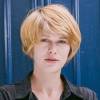 Christine Schoerkhuber
Christine Schoerkhuber 